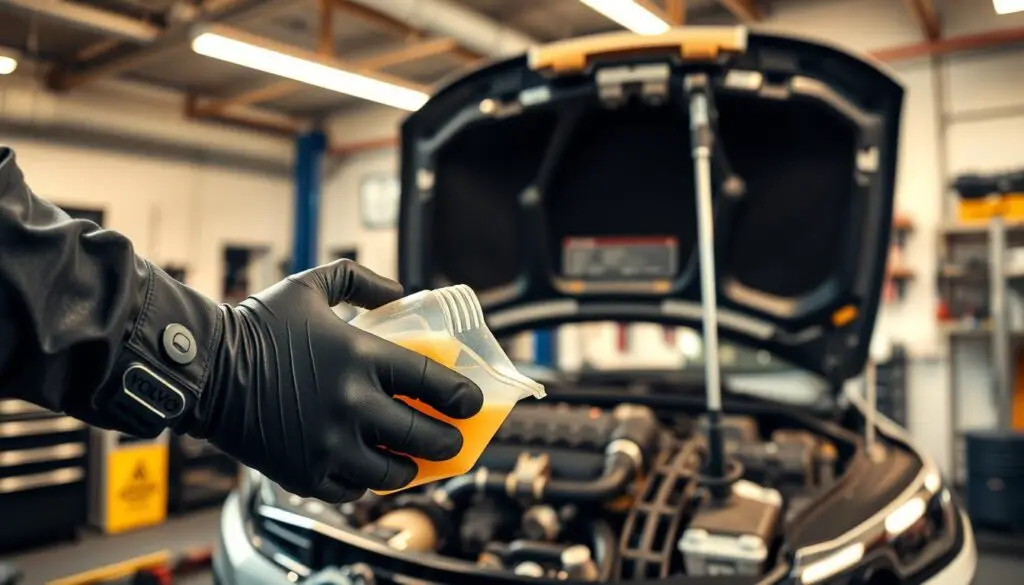Understanding the intricacies of Volvo transmission systems is crucial for maintaining the health and performance of your vehicle. Transmission issues can lead to significant problems if not addressed promptly.
Identifying and fixing transmission faults early on can save time and money. This guide will walk you through the basics of diagnosing and repairing Volvo transmission problems, setting the stage for more detailed procedures in subsequent sections.
Key Takeaways
- Understanding Volvo transmission systems is vital for vehicle maintenance.
- Early diagnosis of transmission faults can prevent further damage.
- Repairing transmission issues promptly can be cost-effective.
- This guide provides a foundation for more advanced diagnostic techniques.
- Proper maintenance can extend the lifespan of your vehicle’s transmission.
Understanding Volvo Transmission Systems
Modern Volvo vehicles rely on sophisticated transmission systems, which are crucial for the vehicle’s overall efficiency and reliability. The transmission is a vital component that enables the engine to operate within its optimal power range, ensuring smooth acceleration and fuel efficiency. Understanding the basics of these systems is essential for diagnosing and repairing transmission faults.
Types of Transmissions in Modern Volvo Vehicles
Volvo vehicles are equipped with various types of transmissions, including automatic and manual transmissions. The choice between these transmission types depends on the vehicle’s model, engine, and intended use. Automatic transmissions are designed for convenience and ease of use, particularly in heavy traffic conditions. They use complex systems, including torque converters and planetary gearsets, to automatically shift gears. On the other hand, manual transmissions offer drivers more control over gear shifting, which can be beneficial for performance driving and engine braking.
How Volvo Automatic and Manual Transmissions Function
Volvo’s automatic transmissions utilize advanced technology, such as electronic control units (ECUs) and solenoid valves, to manage gear shifts smoothly and efficiently. These transmissions are designed to adapt to different driving conditions, optimizing performance and fuel economy. In contrast, manual transmissions rely on the driver’s input to shift gears using a clutch and gear selector. The design of manual transmissions in Volvo vehicles focuses on providing a responsive and engaging driving experience. As a noted automotive expert once said,
“The art of transmission engineering lies in creating a seamless interface between the driver, the engine, and the gears.”
Common Symptoms of Volvo Transmission Problems
Identifying transmission problems in your Volvo early on can save you from costly repairs down the line. Volvo transmission issues can manifest in various ways, and being aware of the common symptoms is crucial for maintaining your vehicle’s health.
Unusual Noises and Vibrations
One of the first signs of transmission trouble is unusual noises or vibrations while driving. If you notice grinding, whining, or clunking sounds, it may indicate worn-out or damaged transmission components. Similarly, vibrations when shifting gears can signal a problem with the transmission’s ability to engage gears smoothly.
Shifting Problems and Delayed Engagement
Difficulty shifting gears or a noticeable delay in gear engagement is another common symptom. This could be due to low transmission fluid levels, worn-out clutch packs, or issues with the transmission control module. For instance, Volvo’s i-Shift transmission can sometimes exhibit delayed engagement or harsh shifting.
Fluid Leaks and Burning Smells
Transmission fluid leaks can lead to serious issues if not addressed promptly. Look out for signs of leakage under your vehicle, and be aware of any burning smells that might indicate overheating transmission fluid.
Warning Lights and Performance Issues
Modern Volvos are equipped with sophisticated warning systems. If the transmission warning light illuminates on your dashboard, it’s essential to have your vehicle checked. Additionally, a decrease in performance, such as sluggish acceleration, can also be a sign of transmission problems.
| Symptom | Possible Cause |
|---|---|
| Unusual Noises | Worn-out transmission components |
| Shifting Problems | Low transmission fluid, worn-out clutch packs |
| Fluid Leaks | Damaged seals or gaskets |
| Warning Lights | Transmission control module issues |
Volvo Transmission Fault: Common Causes, Diagnosis & Repair
The process of diagnosing and repairing transmission faults in Volvo vehicles involves several key steps, including code reading, fluid inspection, and identifying the type of failure. Understanding these processes is crucial for effective transmission repair.
Using OBD Scanners to Read Transmission Codes
One of the first steps in diagnosing a Volvo transmission fault is using an OBD scanner to read transmission codes. Modern OBD scanners can interface with the vehicle’s onboard computer to retrieve fault codes related to the transmission. For a comprehensive list of Volvo fault codes, you can refer to resources like Volvo Fault Codes List. These codes provide valuable insights into the nature of the problem, whether it’s related to solenoid performance, fluid pressure, or other transmission-related issues.

Inspecting Transmission Fluid Quality and Level
Inspecting the transmission fluid quality and level is another critical step in diagnosing transmission faults. Low fluid levels or contaminated fluid can lead to a range of problems, including slipping, hesitation, and unusual noises. Checking the fluid involves locating the transmission dipstick, checking the level against the recommended level, and assessing the fluid’s color and consistency. Healthy transmission fluid is typically a light brown or pink color; dark or black fluid indicates contamination or degradation.
| Fluid Condition | Possible Cause | Recommended Action |
|---|---|---|
| Low Fluid Level | Leak or insufficient fill | Check for leaks, top off fluid |
| Dark or Black Fluid | Contamination or degradation | Change transmission fluid and filter |
| Burning Smell | Overheating or worn-out fluid | Check fluid level, consider fluid change |
Identifying Mechanical vs. Electronic Failures
Volvo transmission faults can be categorized into mechanical and electronic failures. Mechanical failures might involve worn-out clutches, bands, or other physical components, while electronic failures could be related to faulty solenoids, sensors, or the transmission control module. Diagnosing the type of failure involves a combination of code reading, fluid inspection, and sometimes, physical inspection of components.
Model-Specific Diagnostic Procedures
Different Volvo models may have unique diagnostic requirements due to variations in transmission design and electronic control systems. For instance, some models might require specific scan tools or procedures for resetting the transmission control module after repairs. Consulting the vehicle’s repair manual or a professional mechanic familiar with Volvo transmissions can be invaluable in these cases.
Step-by-Step Transmission Repair Procedures
Transmission repairs can seem daunting, but breaking them down into manageable steps makes the process more straightforward. Whether you’re dealing with a slipping transmission, delayed gear engagement, or other issues, following a systematic approach is key to a successful repair.
Transmission Fluid and Filter Replacement
One of the most common and crucial transmission repair procedures is replacing the transmission fluid and filter. Over time, transmission fluid can degrade, losing its lubricating properties and potentially causing damage to the transmission. To replace the fluid and filter:
- Locate the transmission pan and drain the fluid into a suitable container.
- Remove the transmission pan to access the filter.
- Replace the old filter with a new one, ensuring it’s properly seated.
- Refill the transmission with the recommended type and amount of fluid.
Tip: Always refer to your Volvo’s service manual for the correct specifications.

Solenoid Testing and Replacement
Solenoids play a critical role in controlling the flow of transmission fluid and facilitating smooth gear shifts. When a solenoid fails, it can cause a range of problems, including erratic shifting and transmission slipping. To test and replace a solenoid:
- Use a multimeter to check the solenoid’s electrical resistance.
- If the solenoid is faulty, disconnect it from the transmission wiring harness.
- Remove the solenoid from the transmission valve body.
- Install a new solenoid, ensuring it’s securely fastened.
Note: Some solenoids are not serviceable separately and may require replacement of the entire valve body.
Valve Body Cleaning and Repair
The valve body is a complex component that directs transmission fluid to the correct clutches and bands. Over time, it can become clogged with debris, leading to transmission problems. To clean and repair the valve body:
- Remove the valve body from the transmission.
- Disassemble it, taking care to note the position of each component.
- Clean the parts thoroughly with a suitable solvent.
- Inspect for worn or damaged parts and replace as necessary.
Caution: This process requires patience and attention to detail to ensure the valve body is properly reassembled.
Advanced Repairs and When to Seek Professional Help
For more intricate Volvo transmission faults, advanced repair techniques are necessary. While some transmission issues can be diagnosed and repaired with basic knowledge, others require specialized expertise.
Torque Converter Issues and Solutions
The torque converter is a critical component of automatic transmissions, facilitating the transfer of power between the engine and transmission. Issues with the torque converter can lead to slipping or hesitation during gear shifts. Common problems include worn-out or damaged converter components. Solutions may involve rebuilding or replacing the torque converter, depending on the extent of the damage.
Transmission Control Module Troubleshooting
The Transmission Control Module (TCM) is responsible for controlling the transmission’s functions. Faults in the TCM can cause a range of issues, including erratic shifting or failure to engage gears. Troubleshooting involves using diagnostic tools to read error codes and monitor the TCM’s performance. In some cases, reflashing or replacing the TCM may be necessary.
When DIY Repairs Are Not Recommended
While DIY repairs can be cost-effective for simple issues, complex transmission problems often require professional expertise. If you’re unsure about the diagnosis or feel uncomfortable with the repair process, it’s best to seek help from a qualified mechanic. They have the necessary tools and experience to handle advanced repairs, ensuring your Volvo’s transmission operates smoothly and efficiently.
- Complex transmission repairs involving multiple components
- Issues requiring specialized diagnostic equipment
- Repairs that involve reprogramming or replacing the TCM
By knowing when to seek professional help, you can avoid further damage to your Volvo’s transmission and ensure a reliable repair.
Conclusion: Maintaining Your Volvo’s Transmission for Longevity
Proper maintenance is crucial for extending the life of your Volvo’s transmission. Regular checks and timely replacements of transmission fluid, filters, and worn-out parts can significantly enhance transmission longevity. By understanding the common causes of transmission faults and following the diagnostic and repair procedures outlined in this guide, you can prevent major issues and ensure your vehicle runs smoothly.
Maintaining your Volvo transmission involves more than just fixing problems as they arise. It requires a proactive approach, including regular inspections and maintenance tasks. By doing so, you can identify potential issues early on and address them before they become major problems. This not only helps in maintaining the overall health of your vehicle’s transmission but also contributes to a safer and more enjoyable driving experience.
By applying the knowledge gained from this guide, you can take the necessary steps to maintain your Volvo’s transmission and ensure its longevity. Regular maintenance, coupled with prompt repairs when needed, is key to preventing transmission faults and keeping your vehicle in optimal condition.
FAQ
What are the common symptoms of Volvo transmission problems?
Common symptoms include unusual noises and vibrations, shifting problems, delayed engagement, fluid leaks, burning smells, and warning lights on the dashboard.
How do I diagnose a Volvo transmission fault?
Diagnosis involves using OBD scanners to read transmission codes, inspecting transmission fluid quality and level, and identifying mechanical vs. electronic failures.
Can I repair my Volvo’s transmission myself?
Some repairs, such as transmission fluid and filter replacement, can be done DIY. However, more complex issues like torque converter problems or transmission control module troubleshooting may require professional help.
What is the importance of transmission fluid quality and level?
Transmission fluid quality and level are crucial for the smooth operation of the transmission system. Low or dirty fluid can cause damage and lead to transmission faults.
How do I know when to seek professional help for my Volvo’s transmission repair?
If you’re unsure about the diagnosis or repair, or if the issue is complex, such as torque converter or transmission control module problems, it’s best to seek professional help.
What are the benefits of maintaining my Volvo’s transmission system?
Regular maintenance can help prevent transmission faults, ensure the longevity of the transmission system, and prevent minor issues from becoming major repairs.
Are there model-specific diagnostic procedures for Volvo transmission faults?
Yes, different Volvo models may have unique diagnostic requirements, and it’s essential to consult the repair manual or a professional mechanic for specific guidance.



